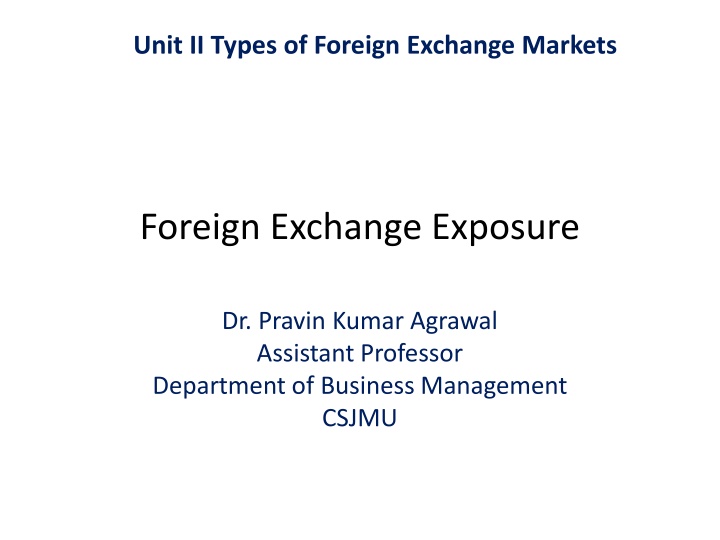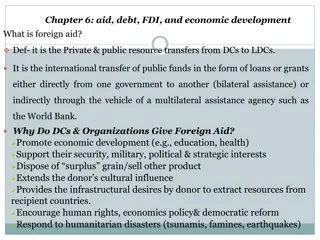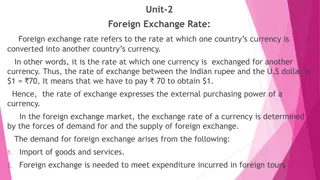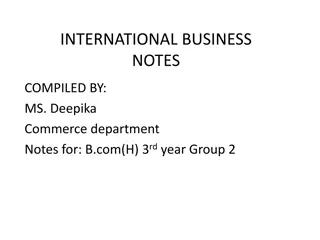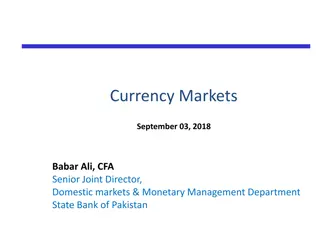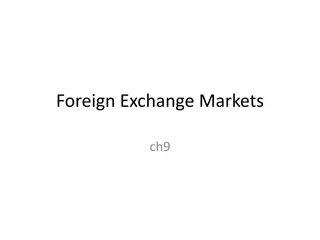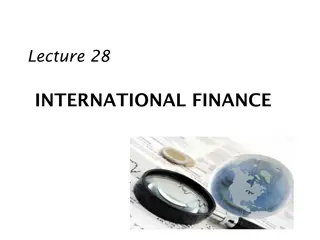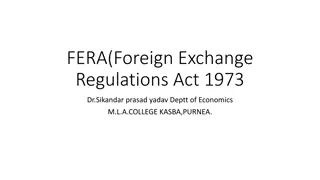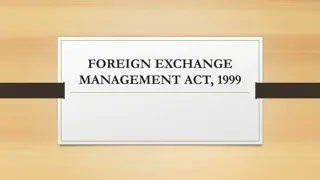Foreign Exchange Exposure
Foreign exchange exposure is crucial in assessing a firm's profitability and market value due to currency fluctuations. This exposure can be transaction, translation, or economic, impacting various aspects of a company's financial performance in global markets.
Download Presentation

Please find below an Image/Link to download the presentation.
The content on the website is provided AS IS for your information and personal use only. It may not be sold, licensed, or shared on other websites without obtaining consent from the author.If you encounter any issues during the download, it is possible that the publisher has removed the file from their server.
You are allowed to download the files provided on this website for personal or commercial use, subject to the condition that they are used lawfully. All files are the property of their respective owners.
The content on the website is provided AS IS for your information and personal use only. It may not be sold, licensed, or shared on other websites without obtaining consent from the author.
E N D
Presentation Transcript
Unit II Types of Foreign Exchange Markets Foreign Exchange Exposure Dr. Pravin Kumar Agrawal Assistant Professor Department of Business Management CSJMU
Foreign Exchange Exposure Foreign exchange exposure is a measure of the potential for firm s profitability, net cash flow and market value because of a change in exchange rates. An importance task of the financial manager is to measure foreign exchange exposure and to manage it so as to maximize the profitability, net cash flow and market value of the firm.
Foreign Exchange Exposure If all exchange rates were fixed in relation to one another there would be no foreign exchange risk. However rates are not fixed and currency values change frequently The measure of the sensitivity of a firm's performance to fluctuation in the exchange rate
Foreign Exchange Exposure With the liberalization of foreign exchange market, firms all over the world have aware of the fact that fluctuations in exchange rates expose their revenues, costs, operating cash flows and their market value to substantial fluctuations. Firms which have exports and imports of goods and services, foreign currencies borrowings and lendings, foreign investments are directly exposed to currencies fluctuations.
Foreign Exchange Exposure The unanticipated changes in the exchange rate also have effect on the future sales volume, prices and costs. These types of exposures are known as operating exposure, economic exposure, or strategic exposure. It measures the change in the present value of the firm resulting from any change in future operating cash flows of the firm caused by an unanticipated change in exchange rates.
Types of Foreign Exchange Exposure Transaction Translation Economic
Transaction Exposure Transaction exposure measures gains or losses that arise from the settlement of existing financial obligations the term of which are stated in a foreign currency. Transaction exposure arises from: Purchasing or selling on credit goods and services when prices are stated in foreign currencies. Borrowing or lending funds when repayment is to be made in a foreign currency.
Transaction Exposure It is the sensitivity of firm's future cash flows from contracts denominated in foreign currency to changes in exchange rate. It is a measure of change in the value of outstanding financial denominated in foreign currency. In other words, Transaction risk refers to the impact of exchange rate changes on the value of committed cash flows i.e. future cash flows obligations which are
Transaction Exposure Short term in nature, usually for less than 1 year Direct impact on cash flows of a firm
Reducing Translation and Transaction Exposure A lead strategy involves attempting to collect foreign currency receivable (payment from customers) early when a foreign currency is expected to depreciate and paying foreign currency payables (to supplier) before they are due when a currency is expected to appreciate. (pay or collect early) A lag strategy involves delaying collection of foreign currency receivables if that currency is expected to appreciate and delaying payables if the currency is expected to depreciate. (pay or collect late)
Hedging Transactions Exposure Forward Market Hedge Money Market Hedge Option Market Hedge
Forward Market In finance, a forward contract, or simply a forward, is a non-standardized contract between two parties to buy or sell an asset at a specified future time at a price agreed upon today. The party agreeing to buy the underlying assets in the future assumes a long position, and the party agreeing to sell the asset in the future assumes a short position. The price agreed upon is called the delivery price, which is equal to the forward price at the time the contract is entered into.
Forward Market In the case of exchanges, when entering a forward contract the buyer hopes or expects that a currency is going to appreciate, while the seller hopes or expects that it will depreciate in near future. If the company is going to receive a large sum of foreign currency from customers as payment, it bears the risk that the currency will depreciate and the company will go short in a currency forward contract. If the company is going to pay its suppliers with foreign currency, it will instead go long.
Translation Exposure Also known as Accounting Exposure. It is the potential for accounting derived changes in owner s equity to occur because of the need to translate foreign currency financial statements of foreign subsidiaries into a single reporting currency to prepare worldwide consolidated financial statements. The key difference between transaction and translation exposure is that the former has impact on cash flows while the latter has no direct effect on cash flows. However, there is board agreement among finance theorists that translation losses and gain are only notional accounting losses and gains.
Translation Exposure It is the sensitivity of firm's foreign currency denominated financial statements to changes in exchange rate. Financial statements of foreign subsidiary are to be translated in home country currency for finalizing the accounts for any given period and holding companies has to prepare consolidated financial statements. Fluctuation in exchange rates will make the value of assets and profit amount different depending on different exchange rate applied.
Translation Exposure Translation exposure measures impact of change in foreign currency exchange rate on the value of Assets and liabilities Important for MNCs with a physical presence in a foreign country Arises because financial statement of foreign subsidiaries which are stated in foreign currency must be restated in the parents reporting currency for the firm to prepare consolidated financial statements No direct impact on cash flows of a firm because Assets and liabilities appearing in the balance sheet are not going to liquidated in the foreseeable future.
Translation Exposure So value of same assets and profit would be different for different period. Thus, Translation exposure arises on the consolidation of assets, liabilities and profits denominated in foreign currency in the process of preparing consolidated accounts. It can be measured as Translation exposure = (exposed assets - exposed liabilities) (change in exchange rate)
Translation Exposure Assume that an Indian company has a wholly owned subsidiary in USA. The exposed Assets of the subsidiary of 200 million dollar and it is exposed liabilities are $100 million the exchange rate changes from $0.020 per rupee to $0.021 per rupee. The potential foreign exchange gain or loss to the company will be calculated as follows In this case the net exposure is:
Translation Exposure Exposed Assets = $200 million Exposed Liabilities = $100 million Net Exposed = $200 - $100 = $100 Pre-devaluation rate ($0.020 = Rs. 1): ($100 million / 0.020) = Rs. 5,000 million Post-devaluation rate ($0.021 = Rs. 1): ($100 million / 0.021) = Rs. 4762 million Potential exchange loss Rs. 5000 Rs. 4762 = Rs. 238 million
Translation Exposure If the post devaluation rate is $0.019 then Post-devaluation rate ($0.019 = Rs. 1): ($100 million / 0.019) = Rs. 5263 million Potential exchange Gain Rs. 5263 Rs. 5000 = Rs. 263 million
Economic Exposure It is the sensitivity of firm's competitive position in the market to changes in exchange rate. It refers to the possibility of the change in the present value of the firm's expected future cash flows due to unexpected change in exchange rates. It is also called operating exposure. It affects the profitability of the firm over a longer period than transaction and translation exposure
Economic Exposure Economic Exposure can be separated into two components transaction exposure and operating exposure. Transaction exposure stems from exchange gains or losses on foreign currency denominated contractual obligations. All the transaction exposure is often included under accounting exposure it is more properly cash flow exposure and hence part of economic exposure. However even if the company prices all contracts in dollar or otherwise hedges its transaction exposure the residual exposure is operating exposure.
Economic Exposure Operating exposure arises because currency fluctuations can alter a company's future revenue and costs that is operating cash flows. Consequently measuring a firms operating exposure requires a longer term perspective, viewing the firm as an on going concern with operations whose cost and price competitiveness could be affected by exchange rate changes. Thus the firm faces operating exposure the moment it invests in servicing a market subject to foreign competition or in sourcing goods or inputs abroad. This investment includes a new product development, a distribution network, or production facilities.
Economic Exposure Economic exposure can prove to be difficult to hedge as it deals with unexpected fluctuations in foreign exchang rates. As the foreign exchange volatility rises, the economic exposure increases and vice versa. Multinational companies having numerous subsidiaries overseas and transactions in foreign currencies face a greater risk of economic exposure.
Techniques to Reduce Economic Exposure
Technique 1 A company can reduce its manufacturing costs by taking its production facilities to low-cost countries. For example, the Honda Motor Company produces automobiles in factories located in many countries. If the Japanese Yen appreciates and raises Honda's production costs, Honda can shift its production to its other facilities, scattered across the world.
Technique 2 A company can outsource its production or apply low-cost labor. Foxconn, a Taiwanese company, is the largest electronics company in the world, and it produces electronic devices for some of the world's largest corporations.
Technique 3 A company can diversify its products and services and sell them to clients from around the world. For example, corporations produce and market fast food, snack food, and sodas in many countries. many U.S. In some countries it will depreciate while in others it will appreciate so foreign operations offset this.
Technique 4 A company can use derivatives and hedge against exchange rate changes. For example, Porsche completely manufactures its cars within the European Union and exports between 40% to 45% of its cars to the United States. Porsche financial managers hedged or shorted against the U.S. dollar when the U.S. dollar depreciated. Some analysts estimated that about 50% of Porsche's profits arose from hedging activities.
